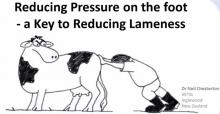Ruth recently attended a really interesting talk and farm walk with New Zealand vet, Neil Chesterton, organised by AHDB Dairy. A couple of clients attended too, but thought we could use this newsletter to pass on some key points.
Neil Chesterton is recognised as one of the experts on lameness, particularly in pasture based systems, and his advice is relevant to any system where cows graze at least part of the time. The main causes of lameness they see are white line disease (including stones going into the white line) and injuries penetrating the sole (as opposed to sole ulcers).
The key point to come out of the day was really the effect that human behaviours can have on cow flow and the impact this has on lameness. The principle being that if cows are under no pressure, they look after their feet, but as soon as they are under pressure, this puts more strain through their feet and leads to lameness. If cows move through your system without being under pressure; even facilities that initially look like they should be bad for cows and feet, can work well with little lameness.
Collecting yard – cows need space to shift position from their walking order to their milking order. This is especially true at the beginning of milking, so, as well as ensuring enough space in the collecting yard (2m squared per Holstein) do not use a backing gate for at least the first 15 minutes, and then move in small increments. Some cows will stand near the front of the collecting yard for some time before going in to the parlour – if you leave enough space for other cows to move around these, cow flow will be better. If you need to move cows in the yard, move slowly and use the balance point to move them on (if you’re not sure where the balance point is, look at this webinar Reducing Pressure on the Foot at 18.40mins time stamp).
Tracks – when a herd of cows is walking along a track, as well as a group of dominant cows at the front of the herd, there are also dominant cows scattered through the herd. It is the dominant cows that set the walking pace for the herd, both by “pulling” the cows behind them and “pushing” the cows in front. Pushing cows at the back will cause less dominant cows to bunch up, putting pressure on their feet, and will have no effect on the cows at the front.
Signs Of Pressure:
Cows bunching up, not following
Sideways touching (cows don’t like to be hemmed in)
Cows reversing (eg: out of a group)
Heads up
The importance of thick soles – obviously thick soles provide better protection against injuries from objects penetrating the sole, but also a thick sole means there is a thicker and stronger white line, which is better able to resist the turning forces that cause damage to the white line. So try and avoid wear or over trimming; leaving cows with thin soles.
For more details, please view the complete webinar Neil Chesterton has recorded for AHDB dairy - Reducing Pressure on the Foot or look at his website - Lameness Management in Dairy Herds or talk to Ruth - 01363 772860.
We are thinking about running a farmskills course on cattle handling – looking at low stress ways to move cattle in yards/races and outside – let Elaine know if you’re interested 01363 772860.


